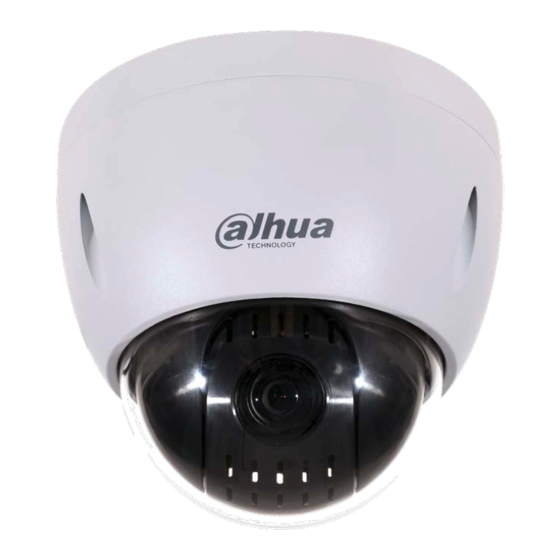Summary of Contents for Dahua 42212TNI
- Page 1 2 MP Network Mini PTZ Camera 42212TNI Quick Start Guide Version 001.001 Dahua Technology USA Inc.
-
Page 2: Table Of Contents
Table of Contents Welcome........................1 Important Safeguards and Warnings..............1 Electrical safety ....................1 Environmental Precautions ................2 Operation and Daily Maintenance ..............3 Lifting Appliance Requirement ................3 Warnings ......................3 FCC Information ....................4 FCC compliance: .................... 4 Legal Notices .................... -
Page 3: Welcome
This manual offers reference material and general information about the basic operation, maintenance, and troubleshooting of a Dahua Network PTZ Camera. Read, follow, and retain the following safety instructions. Heed all warning on the unit and in the operating instructions before operating the unit. -
Page 4: Environmental Precautions
Ensure a service technician uses replacement parts specified by the manufacturer, or that have the same characteristics as the original parts. Unauthorized parts may cause fire, electrical shock, or other hazards. Dahua is not liable for any damage or harm caused by unauthorized modifications or repairs. -
Page 5: Operation And Daily Maintenance
• Dahua recommends the use of a thunder-proof device in concert with the unit. • Do not touch the CCD or the CMOS optic sensor. Use a blower to clean dust or dirt on the lens surface. -
Page 6: Fcc Information
1.3 Legal Notices Copyright This user guide is ©2018, Dahua Technology Company, LTD. This user guide is the intellectual property of Dahua Technology Company, LTD and is protected by copyright. All rights reserved. Trademarks All hardware and software product names used in this document are likely to be registered... -
Page 7: Disclaimer
• Video loss is inherent to all digital surveillance and recording devices; therefore Dahua cannot be held liable for any damage that results from missing video information. To minimize the occurrence of lost digital information, Dahua recommends multiple, redundant recording systems, and adoption of backup procedure for all data. -
Page 8: Unpacking
2 Unpacking This equipment should be unpacked and handled with care. If an item appears to have sustained damage during shipping, notify the shipper immediately. Verify that all the parts listed below are included. If an item is missing, contact customer support or your local representative. -
Page 9: Installation And Configuration
Certain cameras include a SDHC card slot for onboard storage that support a 128 GB Micro SD card. Dahua recommends using a SanDisk Extreme Micro SD card (or an equivalent substitute) as these cards have been fully tested without issue and the SanDisk Extreme line is better suited for constant recording. -
Page 10: Device Installation
A readily accessible 2-pole disconnect device with a contact separation of at least 3 mm must be incorporated. Note: Dahua recommends attaching a “drip loop” (flex or hard conduit) during installation to ensure condensation does not form in the mount or the conduit. -
Page 11: Preparing The Camera
4.1 Preparing the Camera Remove the camera, the mount accessories and any hardware packages from the boxes. Remove the camera from the plastic wrapping and place the camera dome-end up in the foam packaging. 4.2 Insert a Micro SD Card Loosen the three screws from the external enclosure. -
Page 12: Mounting The Camera To A Ceiling
4.3 Mounting the Camera to a Ceiling Place the mounting template against the ceiling and mark the location of the center hole and the three perimeter mounting holes. Pre-drill the three perimeter holes as marked on the wall for the expansion bolts, using a drill bit that is no wider than the expansion bolt. - Page 13 Figure 4-3 Secure the three screws in external enclosure to the pedestal. 10. Make the proper wiring connections and supply power to the camera. Note: The video connection is covered by a heat-shrink tube. Once the video connection is made, gently heat the tube to seal the connection and make it waterproof.
-
Page 14: Network Configuration
5 Network Configuration Dahua IP cameras feature a built-in Web interface to control all aspects of camera operation. This section includes details about the supported network protocols, configuring IP addresses, and configuring alarms and local recording options. Refer to the camera’s Operations Manual for full details. -
Page 15: Modifying The Ip Address
Port – A port is an endpoint to a logical connection in an IP network. Dahua supplies the ConfigTool to access and to modify the network settings of a device. Refer to the Operation Manual, available on the CD included with the camera or on Dahuasecurity.com, for complete information. -
Page 16: Accessing The Web Interface
5. Click the Net icon at the top of the ConfigTool. 6. Modify the IP Address and any other applicable network parameter. 7. Click Save to finish modification and store the modified network parameters. Figure 5-2 5.4 Accessing the Web Interface Each camera can be accessed directly from the Internet Explorer Web browser. -
Page 17: Configuring Alarms
5.5 Configuring Alarms The device’s Web Interface offers a Relay Activation page to configure alarms and to set alarm responses. Figure 5-4 1. Access the Web Interface for the device and click the Setup tab. Expand the Event menu, then choose the Alarm page. Set the alarm input and output parameters in the Relay Activation page. - Page 18 2. Select the recording medium for each event Recorded and Snapshot event, Scheduled, Motion Detect and Alarm. Select the Local check box to record an event to the Micro SD card. 3. Click the Local tab to view the used capacity and the total capacity of the Micro SD card. Figure 5-6 4.
- Page 19 Figure 5-8...
- Page 20 Dahua Technology USA Inc. 23 Hubble, Irvine, CA 92618 Tel: (949) 679-7777 Fax: (949) 679-5760 Email: sales.usa@global.dahuatech.com Rev 001.001 © 2018 Dahua. All rights reserved. Design and specifications are subject to change without notice.

















Need help?
Do you have a question about the 42212TNI and is the answer not in the manual?
Questions and answers